Mass Spectrometry
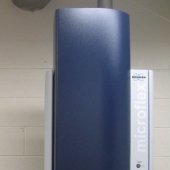
MALDI-TOF
Bruker Microflex LRF
Contact: Andrew Galerneau
Location: ChemSci S002
This equipment is the highest-performance benchtop MALDI-TOF mass spectrometry system on the market. The MALDI-TOF Bruker Microflex LRF is sensitive enough to analyze biomolecules (e.g., DNA, proteins, peptides, and sugars) and large organic molecules (e.g., polymers, dendrimers, and other macromolecules), which tend to be fragile and fragment when ionized by more conventional methods. The instruments capabilities include both a reflective mode, for enhanced isotopic resolution, and a linear mode. Current departmental projects employing this instrument include analysis of polymers, analysis of trypsin-digested proteins, verification of synthesized oligomeric DNA, and mass verification of organic-synthesis targets.
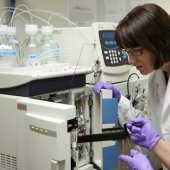
LC-MS
Thermo Finnigan LCQ Advantage Ion-Trap
Contact: Jerry Lutz
Location: GLRC
The ion-trap LC mass spectrometer is used to separate and identify molecules and their structure. Generally used for large, nonvolatile compounds with boiling points greater than 300 degrees Celsius, this instrument separates mixtures using liquid chromatography and then identifies components using a mass spectrometer detector.
Nuclear Magnetic Resonance Spectroscopy
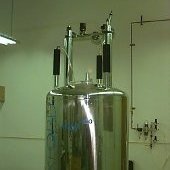
NMR
Varian 400MHz
Contact: Jerry Lutz
Location: ChemSci S004
The NMR is used to determine the structure of molecules. The instrument has capabilities to measure proton, carbon, fluorine, phosphorus and other elements (quad probe, broad-band probe, indirect detection probe). The use of this equipment requires a user fee ($8.00). Training is required prior to use of the instrument.
DNA/RNA Synthesizers
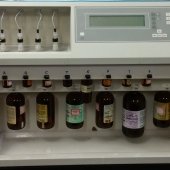
DNA/RNA Synthesizer
ABI 394, 8-Base/4-column
Contact: Shiyue Fang
Location: ChemSci 603
This instrument is used in the development of technologies for the synthesis of base-labile oligonucleotides (a molecule containing 220 nucleotides), non-chromatographic purification of synthetic oligonucleotides, and development of next-generation antisense drugs.
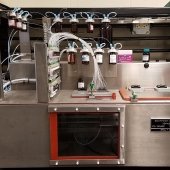
MerMade 6 DNA Synthesizer (BioAutomation)
Contact: Shiyue Fang
Location: ChemSci 405
The MerMade 6 Oligonucleotide synthesizer is designed to synthesize DNA, RNA LNA oligonucleotides in a column format using standard or modified chemistries. It is an economical, versatile, medium-throughput platform that synthesizes DNA oligonucleotides with fast cycle times and very low reagent consumption. The MerMade 6 is capable of making a combination of standard, degenerate, and modified oligonucleotides in the same run with scales varying from 50 nmole to 5 umole and allows for real-time monitoring progression of DNA synthesis.
Optical Spectroscopy
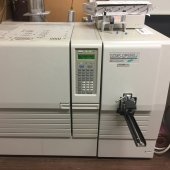
GC-MS
Shimadzu GCMS-QP5050
Contact: Jerry Lutz
Location: ChemSci S002
The gas chromatograph–mass spectrometer instrument is designed to separate and identify molecules in compounds having boiling points less than 300 degrees Celsius. The GC-MS pattern of fragmentation is much more reproducible than that of an LC-MS; therefore, known molecules can be identified using the operating software, which uses a reference library. This instrument is capable of chemical ionization and can be used with a direct-insertion probe.
FTIR
Perkin Elmer, Spectrum One
Contact: Andrew Galerneau
Location: ChemSci 601
The FTIR spectrometer uses infrared radiation to vibrate the bonds between atoms found predominately in organic compounds. The frequency of these vibrations readily reveals the functional groups present in a molecule. Detailed structural information and identification can be obtained upon careful analysis of the infrared spectrum.
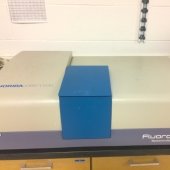
Fluorometer
Horiba Jobin Yvon FluoroMax-4
Contact: Jerry Lutz
Location: ChemSci 408
Fluorometers measure the emission of molecules that absorb ultraviolet–visible (UV-VIS) radiation and then emit it at a longer wavelength.
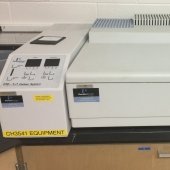
UV-VIS
Perkin Elmer Lamda 35
Contact: Jerry Lutz
Location: ChemSci 408
This spectrophotometer, capable of both quantitative and qualitative analysis, measures the absorbance of ultraviolet and visible light by molecules containing pi electrons. The instrument is connected with a Peltier research-grade temperature controller.
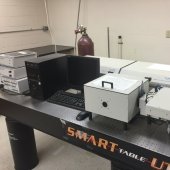
Fluorescence and Phosphorescence Lifetimes
PTI Fluorescence System
Contact: Jerry Lutz
Location: ChemSci S014
This system utilizes a nitrogen laser to pump a chemical dye Laser which promotes samples into an excited state; then, using precisely timed delays and a photon multiplier as a detector, measures the intensity of the emission from the sample as it fluoresces/phosphoresces. A plot of the intensity verses delay time is then analyzed to determine the lifetime(s) of the sample's emissions.